How To Care For A Parrot?
This page contains affiliate links. We may earn money or products from the companies mentioned in this post through our independently chosen links, which earn us a commission. Learn More
General Stats:
- Pet Type: Bird
- Size: Small, medium, large
- Diet: Omnivore
- Lifespan: Up to 25 years
When you think about parrots, what do you picture? Maybe you imagine a big, colorful bird with a long tail and a loud mouth. Perhaps you picture a small white parrot with a yellow crest. Or maybe you think of a gray parrot with a black beak and a red underside to its tail.
All of these images are correct. In fact, there are over 350 different species of parrot, all belonging to the family Psitticidae in the order Psittaciformes.
Though all the various parrot species are unique, some are more popular than others as pets. Cockatiels, cockatoos, and parakeets are incredibly popular, as a conures and lovebirds. Larger parrot species like macaws and eclectus can be more challenging to keep, but equally rewarding.
Before you bring home a pet parrot, do your research to be sure you’re up for the challenge. Here’s what you need to know about caring for a parrot.
Habitat Setup For Parrots
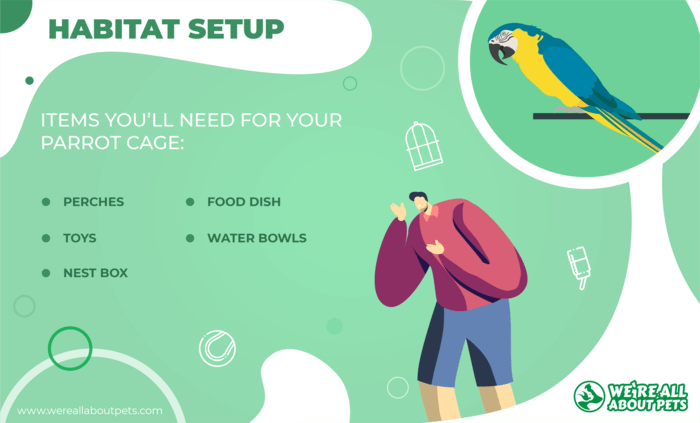
The first thing new parrot owners need to think about is the type of parrot they want to keep. If you visit the pet store, you’ll most likely find smaller species like parakeets and parrotlets. To find larger parrots like the Amazon or African grey, you may need to contact a breeder directly.
Once you’ve decided on the type of parrot you want, you’ll have to find the right bird cage. Choosing a pet bird cage comes down to the size of the parrot and its activity level.
A large parrot needs a large cage, but you should plan to give your bird a lot of time outside the cage for exercise and interaction. Smaller parrots will likely spend more time in the cage, so you’ll still need a large cage to account for exercise.
Your parrot’s cage should at least twice the length of the bird’s wingspan, though the larger the cage you can provide, the better. Think about the proper bar spacing according to your bird’s size.
Here are some of the items you’ll need for your parrot cage:
- Perches – Provide at least two perches of differing thickness and texture. Place them at different heights throughout the cage so your parrot can move around.
- Toys – Things like ladders, ropes, bells, squeakers, mirrors, and balls provide your parrot with mental stimulation as well as exercise, so be sure to provide a variety.
- Nest Box – Most parrots will sleep on a perch, but you should provide a nesting box if you’re keeping a mating pair together. The size should be appropriate for the type of parrot.
- Food Dish – Parrot food bowls should not be placed directly under perches and they should be made from durable materials like stainless steel. Avoid anything coated in Teflon because it can be toxic for birds.
- Water Bowls – Your parrot should have access to clean water at all times and most birds prefer water dishes to a water bottle.
In addition to thinking about what to put in your bird’s cage, you should think about where you put it as well. Parrots tend to need a certain amount of daily interaction, so don’t place the cage anywhere too out of the way. Neither should it be in a high traffic area, however.
Place your parrot’s cage away from windows and air vents and out of direct sunlight. Fluctuations in temperature can lead to health problems, so try to keep your pet’s environment stable.
Parrot Diet
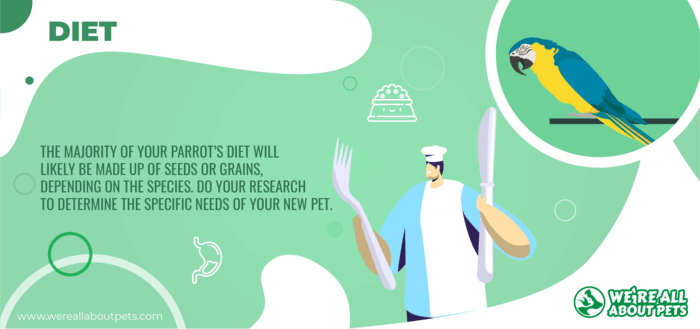
In the wild, a parrot’s diet varies greatly depending on the species. Smaller parrots tend to eat grass seeds as the foundation of their diet, supplementing them with grains, berries, and other vegetation. Larger parrots will also eat seeds, nuts, and grains but more of their diet is likely to come from fresh fruits. Most parrots will eat insects as well, which technically makes them omnivores.
Here are some quick facts about the ideal parrot diet:
- The majority of your parrot’s diet will likely be made up of seeds or grains, depending on the species. Do your research to determine the specific needs of your new pet.
- Consider feeding your parrot commercial pellets which are formulated for birds of your parrot’s species or size – these provide complete and balanced nutrition.
- Complement your parrot’s staple diet with fresh foods like fruits and vegetables, offering a large variety over the course of the week – some species need more fresh fruit in their diet.
- Offer limited treats a few times a week in small amounts – things like roasted unsalted nuts, high-fat seeds, cooked egg, and dried insects generally make good treats.
- Consider offering a cuttlebone in your parrot’s cage to help meet his needs for calcium – you might consider other supplements as well, with your vet’s approval.
On top of your parrot’s diet, be sure to provide unlimited access to clean water as well. Fresh fruits and vegetables provide some hydration, but water should be available at all times.
Parrot Veterinary Care
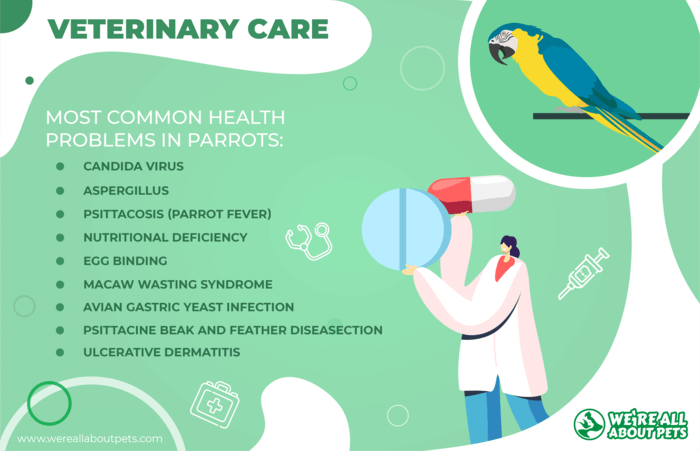
Most veterinarians aren’t qualified to care for birds, so you might need to do some research to find an avian veterinarian in your area. Take your bird to the vet within a few weeks of bringing him home and then take him back every 6 to 12 months for checkups.
Regular veterinary care is the key to catching signs of illness early when they are still treatable. It also helps to have an understanding of some of the common health problems in birds so you know what to look for and you can call your vet at the first sign of trouble with your new parrot.
Here are some of the most common health problems in parrots:
- Candida virus
- Aspergillus
- Psittacosis (parrot fever)
- Nutritional deficiency
- Egg binding
- Macaw wasting syndrome
- Avian gastric yeast infection
- Feather picking
- Psittacine beak and feather disease
- Ulcerative dermatitis
Caring for a pet parrot can be expensive, especially if your parrot gets sick. You might want to consider pet insurance to help offset your costs or put a certain dollar amount in savings each month so you have it in case of an emergency.
Parrot Fun Facts
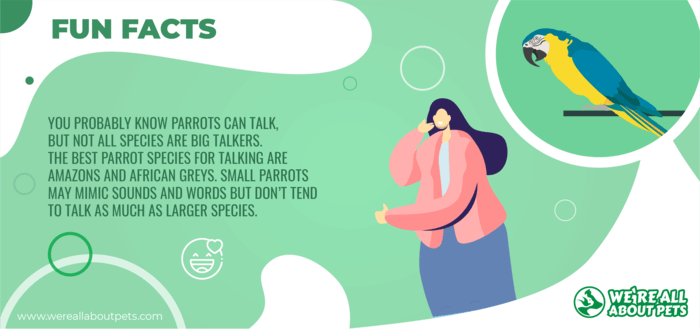
- You probably know parrots can talk, but not all species are big talkers. The best parrot species for talking are Amazons and African greys. Small parrots may mimic sounds and words but don’t tend to talk as much as larger species.
- Parrots have four toes on each foot, like most other birds. Most birds have their toes in a three-in-front-one-behind arrangement, configured for maximum grip, but parrots have two in front and two behind. Their toes act more like two pairs of opposable thumbs.
- Though most of the 350 species of parrot are found in subtropical and tropical regions, some are native to the alpine regions of New Zealand where they nest in burrows in the ground. The endangered maroon-fronted parrot is found at elevations around 6,000 feet in the Sierra Madre Oriental Mountains of Mexico.
- Due to a combination of habitat destruction and poaching, nearly one-third of the world’s parrot species are endangered. Logging has decimated nearly 99% of the African grey population, for example.
- Most species of parrot do not exhibit sexual dimorphism – males and females look nearly identical. One exception is the Solomon Island eclectus, a species in which males and females look so different they were thought for many years to be two separate species.
- Parrots have taste buds in the backs of their throats, but most of the 300 taste glands they possess are located in the roof of their beaks.
- Typically divided into three categories, parrots vary widely in size. The largest species, the hyacinth macaw, measures nearly 3.5 feet from head to tail. On the other end of the spectrum, the buff-faced pygmy parrot weighs barely an ounce.
Parrots are far from the easiest pet to keep, but parrot owners will tell you they are very rewarding.
Think about what type of parrot you want and do your research to learn that species’ particular requirements. It’s important to make sure you have the time and resources to dedicate to proper parrot care. Most species have a long life span, so remember it’s a long-term commitment.
Frequently Asked Questions
How long do parrots live?
The average lifespan for a pet parrot is about 25 years, though it depends on the species.
How much do parrots cost?
The cost to keep a pet parrot varies widely from one species to another. Small parrots like budgies can be relatively inexpensive, around $30 for the bird and another $100 or so for a small cage and supplies. Larger species can cost well over $500 for the bird alone with hundreds more dollars spent on the cage and necessary supplies. When estimating the cost to keep a pet parrot, be sure to factor in the cost to feed your new pet and provide veterinary care as well.
How big do parrots get?
Parrots come in a wide range of sizes ranging from the smallest (parrotlets) to the largest (hyacinth macaw). Small parrot species include budgies, small conures, and lovebirds while medium species include the Amazon parrot, lories, and cockatiels. Some of the largest species include African grey parrots, cockatoos, and macaws which grow to 40 inches in length or more.
What do parrots eat?
The wild diet of a parrot varies from one species to another. Most parrots are omnivores with smaller species feeding primarily on seeds and grains while larger parrots tend to eat more fruit. Most parrots will also consume insects, though fruits and vegetation are a larger part of the diet.
Are parrots good pets?
Whether parrots are good pets depends what you’re looking for. If you’re looking for a low maintenance pet, you probably want to look elsewhere. Proper care of a parrot includes daily interaction with your parrot as well as opportunities for exercise and mental stimulation. If you’re looking for an intelligent and unique pet, however, and you’re willing to put some time and effort into bird care, parrots make great pets.
Are parrots messy?
Yes, parrots have a reputation for being a bit messy. If you have smaller parrots that spend most of their time in a cage the mess will be contained. You will always find seed and feathers scattered around the outside of the cage, however. If you have a larger parrot that spends a lot of time outside the cage, the mess may extend a bit further.
Where do parrots come from?
Parrots can be found in warm climates in most parts of the world. The greatest diversity of parrot species can be found in Central and South America and in Australia and southern Asia.
Do parrots bite?
Most parrots will bite if they feel threatened or mistreated, but it generally isn’t an issue for competent parrot owners. If your parrot bites you often, you should consider whether you’re making a mistake or that your parrot might be trying to communicate something to you, so pay attention.
Do parrots sleep?
Yes, most parrots are diurnal which means they sleep at night and are active during the day. You should give your parrot 10 to 12 hours of sleep at night, covering the cage to keep it dark and quiet.
How long are parrots pregnant for?
Parrots lay eggs rather than producing live young and some species will lay eggs even in the absence of a mate (they will be unfertilized and won’t hatch). Clutch size varies from one species to another and incubation periods for the eggs range from about 18 to 30 days.






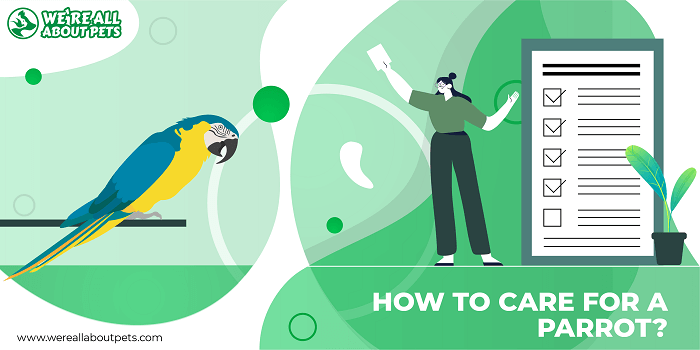
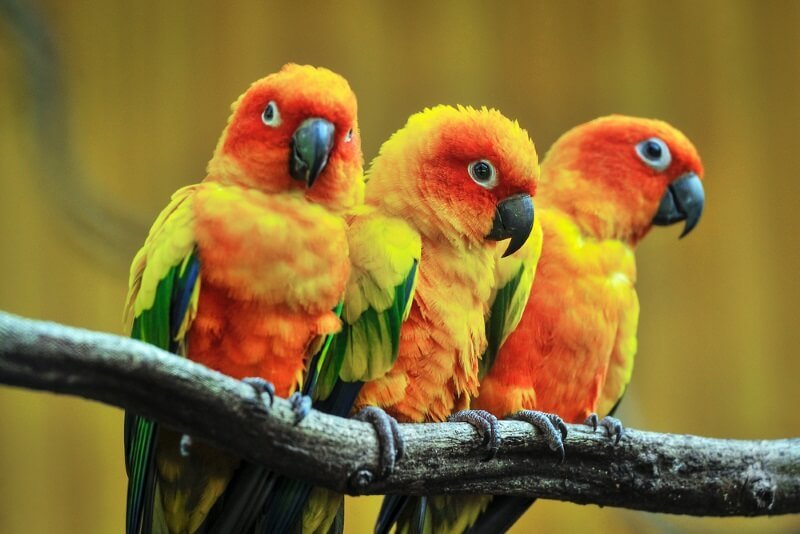
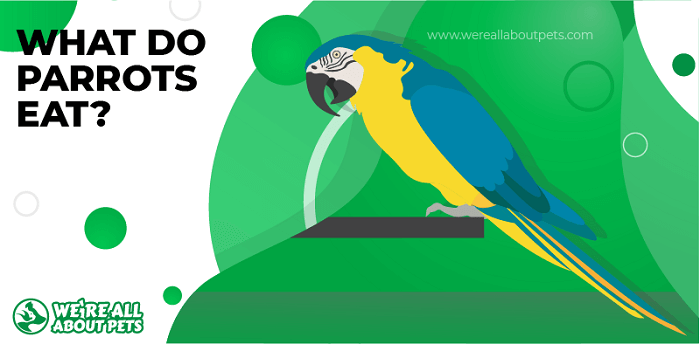
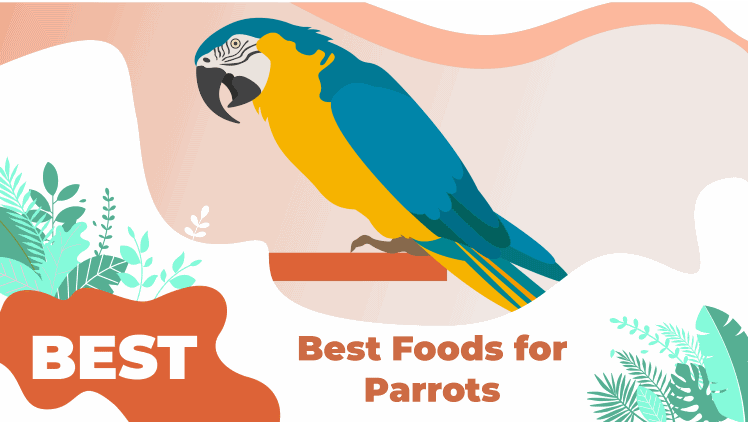
Maria Sullivan
I am giving this article 1 star...1 for getting a few things right like vetting. I can't go into everything that is wrong with this article but do not use it as a resource. It doesn't advise properly. Telling people to do their research on the internet when it is full of misinformation such as this article is not helpful. If you want to know about parrots, how long they live, which one is best for your family, what to feed them, how to dress out their cages, enrichment, foraging, exercise, how to learn bird body language, go to the people who have worked hard to keep them alive, learned by others mistakes, sees them being fed to death, being their ultimate guardians, call a parrot rescue. Adopt don't shop.